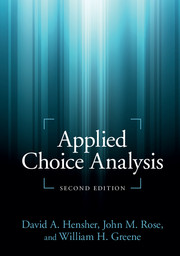Book contents
- Frontmatter
- Contents
- List of Figures
- List of Tables
- Preface
- Part I Getting started
- 1 In the beginning
- 2 Choosing
- 3 Choice and utility
- 4 Families of discrete choice models
- 5 Estimating discrete choice models
- 6 Experimental design and choice experiments
- 7 Statistical inference
- 8 Other matters that analysts often inquire about
- Part II Software and data
- Part III The suite of choice models
- Part IV Advanced topics
- Select glossary
- References
- Index
1 - In the beginning
from Part I - Getting started
Published online by Cambridge University Press: 05 June 2015
- Frontmatter
- Contents
- List of Figures
- List of Tables
- Preface
- Part I Getting started
- 1 In the beginning
- 2 Choosing
- 3 Choice and utility
- 4 Families of discrete choice models
- 5 Estimating discrete choice models
- 6 Experimental design and choice experiments
- 7 Statistical inference
- 8 Other matters that analysts often inquire about
- Part II Software and data
- Part III The suite of choice models
- Part IV Advanced topics
- Select glossary
- References
- Index
Summary
Education is a progressive discovery of our own ignorance.
(Will Durant, 1885–1991)Choosing as a common event
Why did we choose to write the first edition of this primer and then a second edition? Can it be explained by some inherent desire to seek personal gain or was it some other less self-centered interest? In determining the reason, we are revealing an underlying objective. It might be one of maximizing our personal satisfaction level or that of satisfying some community-based objective (or social obligation). Whatever the objective, it is likely that there are a number of reasons why we made such a choice (between writing and not writing this primer) accompanied by a set of constraints that had to be taken into account. An example of a reason might be to “promote the field of research and practice of choice analysis”; examples of constraints might be the time commitment and the financial outlay.
Readers should be able to think of choices that they have made in the last seven days. Some of these might be repetitive and even habitual (such as taking the bus to work instead of the train or car), buying the same daily newspaper (instead of other ones on sale); other choices might be a once-off decision (such as going to the movies to watch a latest release or purchasing this book). Many choice situations involve more than one choice (such as choosing a destination and means of transport to get there, choosing where to live and the type of dwelling, or choosing which class of grapes and winery in sourcing a nice bottle of red or white).
- Type
- Chapter
- Information
- Applied Choice Analysis , pp. 3 - 15Publisher: Cambridge University PressPrint publication year: 2015



